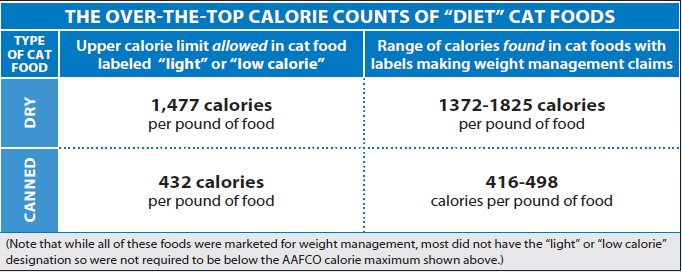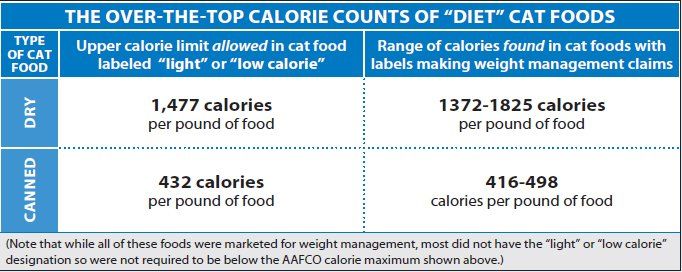Believe it or not, you can find at least 50 cat foods on the market with promises on their labels that claim everything from “weight loss” to “reduced calorie” to “weight management.” But just what do these phrases mean? Unfortunately, they can mean whatever the manufacturer wants them to.
Unless a cat food label uses the term “light” or “low-calorie” — both of which mean that a food can’t contain more than a certain number of calories for its weight, food manufacturers are legally allowed to make “diet” cat foods as calorically dense as they wish.
And they do — to the point that some so-called weight management foods actually contain more calories than non-diet foods. And you can’t easily tell the difference because unlike food for people, most pet foods do not have to be labeled with calorie counts.
Only those labeled “light,” “low-calorie,” “less calories” or “reduced-calorie” must contain calorie information — but not calories per serving. Current regulations require only that labels state calories per pound of food, which can be useless information for most owners because they feed by volume (half a cup, for instance), not by a food’s weight. Thus, a well-intentioned switch to “diet” food can possibly end up making your cat even fatter.
For that reason, it’s best to discuss a diet plan with your veterinarian — or even a veterinary nutritionist — to make sure you’re on the right track with the food you choose and how much you plan to feed.
In a study she co-authored and published in the Journal of the Veterinary Medical Association, Cummings School Weight Management Clinic Director Deborah Linder, DVM, made the finding that some “diet” foods are even higher in calories than non-diet foods. In looking at 49 diets for cats that had weight management claims, she found that they differed in calories by more than two-fold: anywhere from 235 to 480 calories per cup for dry food and 78 to 172 calories per can of wet food (though the sizes of the cans did vary). Four in 10 of the foods had more calories than allowed in “light” cat food by the Association of American Feed Control Officials. Feeding recommendations on labels were all over the place, too.





